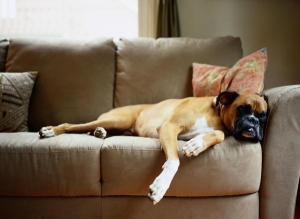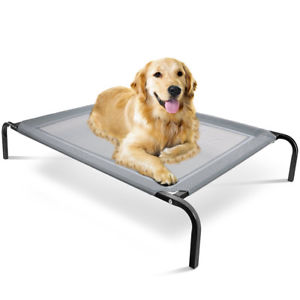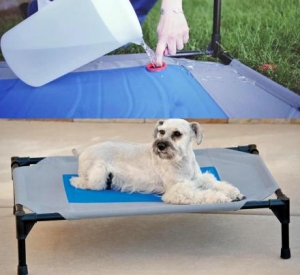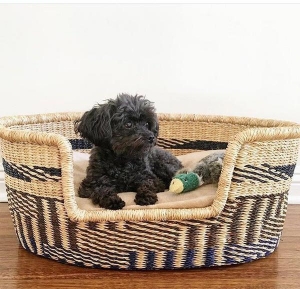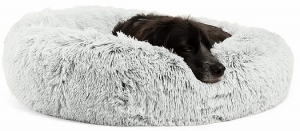February 23, 2019
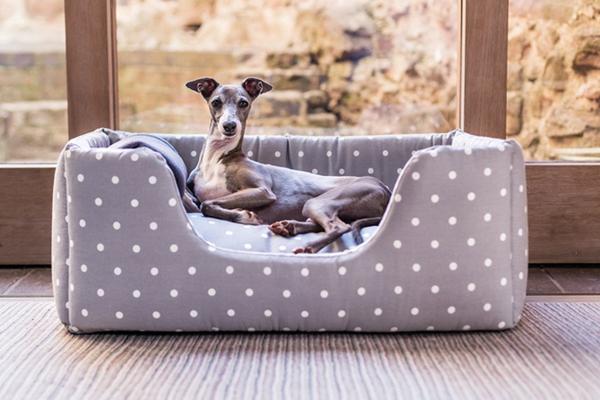
Best Dog Bed
Sleeping Like a Log Dog

Did you sleep well last night? If so, chances are this is at least partly because you have a nice warm bed. Human bed-frames might come in different models and materials, but the basic design is the same and a comfortable mattress is a key ingredient of a good night’s sleep. You probably spent a lot of time, effort and money choosing a mattress that is just right (Goldilocks and the Three Bears, anyone?) because there is nothing worse than tossing and turning or waking up with aches and pains instead of feeling refreshed and ready for the day.
Well, your four-legged friend is exactly the same. He/she needs beauty sleep just like you, and when I say beauty sleep, I mean restorative sleep designed to promote your dog’s health, well-being and energy. In fact, dogs sleep more than humans – maybe that’s where we get the expression ‘dog tired’ from. Expect a puppy to sleep for around 18+ hours a day (that’s more than a newborn infant) and adult dogs for somewhere between 12-14 hours. Older dogs, like my 12 year-old border collie Kobe, will gradually begin to sleep for a longer and longer chunk of the day. It’s worth making yourself familiar with your dog’s sleeping patterns if possible, as any sudden change in this sleep schedule can alert you to potential health issues.
Research suggests that bigger dogs sleep more than smaller ones. As an owner of working breeds this makes sense; Kobe and Bella have long, energetic walks that include time off-leash to expend extra energy; smaller breeds are less likely to have such intensive workouts. And for giant breeds like great Danes, St. Bernards and mastiffs, lugging around all that extra flesh is bound to be tiring! But this is just my theory – I couldn’t find any definitive answer as to why large breeds sleep more than their more diminutive cousins – and there is a lot of anecdotal evidence online of smaller breeds like Shih Tzus or pugs snoozing the hours away. I’d be interested to hear from owners of smaller breeds, or those who own both large and small breeds. Maybe small dogs are just as active as working breeds and I’m guilty of dog ‘size-ism’? Whatever the case, your dog pal will need the best dog bed possible for all those (long or short) dog naps.
People say that dogs sleep ‘with one eye open’ because they can react very quickly to a sudden or unusual noise or movement – much quicker than sleeping humans. But in fact this observation probably just reflects the type of sleep your dog is having. Like humans, dogs have different stages of sleep: slow wave and REM (rapid eye movement). Unlike humans, who spend up to 25% of sleep time in REM (the dreaming phase of sleep), REM in dogs accounts for just 10% of their sleep time. So if your pooch is able to leap out of a sleep, alert and ready for action, you can bet that he/she has either been in the slow wave stage, or just napping. It’s easy to spot when your dog is in REM sleep, and rather amusing too: twitching, whining, barking and flailing paws are a sure sign that dog dreams (or even nightmares) are under way.
The best dog beds will be both sturdy and pleasant for your dog to sleep on or in, regardless of whether they are to be used inside or outside.
Given the importance of sleep to your dog’s general all-round health, it’s important to provide your pooch with the best dog bed available. There’s a huge selection available and your decision needs to take a number of things into account, such as the dog breed and size, the climate or whether the bed is to be used inside or outside. Consider what you would find important if you were choosing a bed for yourself and apply that to your dog’s situation too. For example, you’d expect the bed frame to be rigid and strong – you wouldn’t be impressed if it broke or became wobbly after a few months, would you? Likewise, your mattress – whether pocket sprung, latex, memory foam or a hybrid – should support your spine and be comfortable too. The best dog beds will be both sturdy and pleasant for your dog to sleep on or in, regardless of whether they are to be used inside or outside.
I know there are some dog owners out there who co-sleep with their pooches. This has never been my style – I love Kobe and Bella to death but I’m too aware of the things they sniff, roll in and excrete, never mind the vast amounts of hair they shed, their dog breath and snoring to extend that invitation to them. Plus I have allergies. Only in exceptional circumstances – dog illness, or late at night after viewing a particularly scary movie – do I even let them sleep in my room. Kobe and Bella have their sleeping quarters and I have mine; they have their own beds and I have mine. Whatever side of the canine co-sleeping fence you sit on, you might find the following articles interesting. All three: one from Psychology Today https://www.psychologytoday.com/us/blog/canine-corner/201709/should-you-let-your-dog-sleep-in-bed-you, one from PetMD https://pets.webmd.com/features/pets-in-your-bed#1, and one from the American Kennel Club https://www.akc.org/expert-advice/lifestyle/should-my-dog-sleep-with-me/ give reliable, balanced information and advice on the matter.
Regardless of whether you share your bed with your dog pal or not, your pooch still needs his own bed, precisely because of the differences in sleeping patterns between humans and dogs described above. Unlike you, dogs will nap frequently during the day and they need their own go-to place to ensure this sleep is beneficial. Raised or elevated dog beds make ideal outdoor dog beds.
Elevated dog beds
If your dog spends time outside – Kobe and Bella are predominantly ‘outside’ dogs – you should provide a bed there for daytime naps. Raised or elevated dog beds make ideal outdoor dog beds. Comprised of a four-legged metal frame (not unlike a human bed frame, minus headboard) with porous fabric stretched over the frame, the best elevated dog beds will be both light and strong. Their raised style has a number of advantages: elevation off the ground not only makes the dog bed more comfortable and snooze-promoting, but also protects your dog from extremes of temperature, whatever the season. In hot weather, air can circulate underneath the bed; in cold weather your pet will never be in direct contact with the ground. The best outside dog beds use nylon mesh as the ‘mattress’ part of the bed. Such mesh is tough and breathable, allowing moisture to pass through; it facilitates air circulation in the hotter summer months; and is easy to rinse clean and quick to dry. Note that some cheaper brands of raised dog beds use hessian sackcloth in place of mesh. I’d advise steering clear of this as it is dusty, easily damaged and sags very quickly. It’s a false economy if you have to replace the dog bed or cover every few months!
Be prepared to move the bed as necessary throughout the year to take account of changing areas of sun/shade and high/low temperature
Obviously, an outside dog bed should be placed in a sheltered, preferably covered location that takes account of the climate. If your garden has no covered area, it’s possible to buy canopies to fit popular models of raised dog bed such as those made by Coolaroo or Kuranda. These versatile waterproof add-ons provide both shade from the sun and shelter from the elements. Be prepared to move the bed as necessary throughout the year to take account of changing areas of sun/shade and high/low temperature. The best elevated dog bed brands will come in a range of sizes to suit your pooch and will offer the option to purchase spare covers just in case your mutt decides to have a nibble – a certainty with puppies and young dogs.
Shop related
These days, Kobe and Bella (spoilt mutts that they are) have a few dog beds each which they use as the whim takes them. But back in the day, when they were less sophisticated, their one bed had to do the job of both indoor and outdoor dog bed. I was therefore obliged to carry them outside every day and in again every evening. Given the amount of shifting back and forward, I deliberately selected ones that are light, durable and waterproof. Elevated dog beds are an excellent choice in that regard. That’s not to say Kobe and Bella always took advantage of my forward-planning: sometimes I’d come home to see either or both of them stretched out on the concrete or on the lawn snoozing for all they were worth. The important thing is that they have the option to use their raised dog bed if they so choose.
Most raised dog beds come flat packed and need to be constructed at home. Fear not all you non-handy types … four screws, an Allen key (included) and ten or fifteen minutes of your time will have your pooch enthroned in his/her new bed. You may need to re-tighten the screws every now and again, as the frame can loosen with use, but this is no big deal. If you are absolutely DIY-averse, your local pet shop should be happy to construct the dog bed for you, but expect this personal service to be reflected in the costs, which are often considerably more expensive than the same product ordered online.
Cooling dog beds
If you live in a warm climate, have hot, humid summers, or if your dog sleeps in a centrally-heated house, you might consider investing in a cooling dog bed. Dogs sweat a little through their pads, but rely mostly on panting to cool down, which is not very efficient. And unlike us, dogs can’t just change into something more comfortable to combat the heat. This is where cooling dog beds come in useful and there is a huge range to choose from. Whether you buy a cooling pad or a mattress the principle is much the same. Most utilise water-absorbent gel crystals (make sure these are nontoxic) and special foam which are activated by the pressure of the dog’s weight. They cool the dog by dissipating heat from your four-legged friend’s body and, depending on the brand, last for between 2 and 4 hours. Most ‘recharge’ automatically by being left in a cool place. Pad styles are light and portable and therefore particularly suited to travel, while mattresses ideal for home-lounging or recuperation from illness/injury. Cooling dog beds are certainly worth considering as an add-on, but won’t replace the other types of beds considered here.
Market leaders
Coolaroo dog beds and Kuranda dog beds are the leaders in the market when it comes to elevated dog beds or outdoor dog beds. The frames are strong and the covers extremely durable. While Coolaroo dog beds and Kuranda dog beds might be a bit more expensive than some, the extra cost is definitely worth it if you want to purchase the best dog bed available for your four-legged friend. These brands will last and last. In fact, I’ve owned a couple of Coolaroo dog beds for about 8 years now, and they are still going strong. I’ve found them to be an excellent purchase – hardwearing and sturdy – and Kobe and Bella love them. The medium-sized Coolaroo dog bed is big enough for both border collie Kobe and for Bella, who is a couple of inches taller – and the nylon mesh covering, which comes in a range of fade-resistant colors, is extremely durable, even for those dogs that have the occasional nibble. I think Bella managed to destroy a cover or two in her puppy teething days. Thankfully, Coolaroo offer replacement covers – a much cheaper option than replacing the whole bed. As for Kuranda dog beds, their raised models are the dog bed of choice for boarding and rescue kennels. The company guarantees that ‘Kuranda dog beds are designed from the outset to perform, out last and be extremely easy to maintain than any other bed made anywhere’ https://www.kurandadogbeds.co.uk/index.php). Quite a claim! More about Coolaroo dog beds and Kuranda dog beds in a later post.
Indoor dog beds
Of course, not all dogs will spend as much time outside as Kobe and Bella. You might not have an outside space for your four-legged pal to run around. Or perhaps you own a toy dog breed, Chihuahua, Pomeranian, Maltese etc., in which case your pooch may spend little or no time outside, other than when out for a walk. These miniature breeds are called lap dogs for a reason: they fit perfectly on an owner’s knee and love nothing more than snoozing away on a living, breathing human ‘bed’. However, this isn’t always practical, so what should you look for in the best indoor dog beds?
First off, there is nothing to stop you using an outdoor dog bed, such as the raised dog beds made by Coolaroo and Kuranda, as an inside bed. I do this with Kobe and Bella’s elevated dog beds, but ‘supplement’ the comfort level by adding padded cushions, mats (bath mats are an excellent option) and/or blankets. However, provided the indoor dog bed is placed in a draught-free, well-ventilated area, there is no real need to have a raised bed at all.
One option, which can be used outside as well, is the basket-style dog bed. These are usually oval in shape and are made of tough, chew-resistant plastic or even wicker. Bear in mind that wicker dog beds are only for indoor use and, while they look great, in my opinion their good looks come at the cost of the dog’s comfort. Would you want to sleep on a wicker mattress? Thought not. Those made of plastic should have ventilation holes in the base to allow air to circulate, or moisture to escape if they happen to be used outside – otherwise you’ll end up with a dog paddling pool every time it rains. This type of dog bed also has rubber feet to prevent slippage – a necessity if it is placed on a wooden or tiled floor. In reality, however, I’ve found that these little rubber feet can come loose and are easily lost.
The big advantage of plastic is that it is durable and very easy to clean. Also the ‘walls’ that surround the dog provide shelter from draughts. Bear in mind, however, basket-style dog beds can be quite unwieldy, especially in bigger sizes, are heavier than raised dog beds, and some dogs find the noise as they climb in and out off-putting. For indoor use, whether plastic or wicker, I would always pair the basket-style dog bed with a cushion or rug. Most brands offer cushions in different sizes to fit snugly into these beds. However, these made-to-measure cushions can be pricey and combined with the cost of the bed may not be the best value for money.
If you want a completely padded dog bed for your four-legged friend, the sky is the limit in terms of style, fabric and comfort. From super thick and comfy futons to dog couches, from igloo to cuddler style, from faux fur to lambswool – the choice is endless. Whatever the breed, size or age, your pooch will find something to suit in the padded dog bed style.
One indoor dog bed option I love is the “Donut Cuddler“. This comes in a range of sizes, and is ridiculously comfortable. I wish I could get a human-sized one. It is cozy, flexible and finished with faux shag fur.
Premium dog beds now include special features for dogs with arthritis such as memory foam.
Advantages: super comfy, stylish and warm.
Disadvantages: Can be more easily chewed and destroyed than rigid plastic beds or elevated dog beds.
Tip: Avoid cheap padded beds like the plague: the outer coverings are just not tough enough to withstand any dog-shaped abuse and the filling materials are poor quality – at best, becoming saggy; at worst a fire or choking hazard if your dog rips the outer cover.
Sweet dreams all you doggies and dog owners out there!
